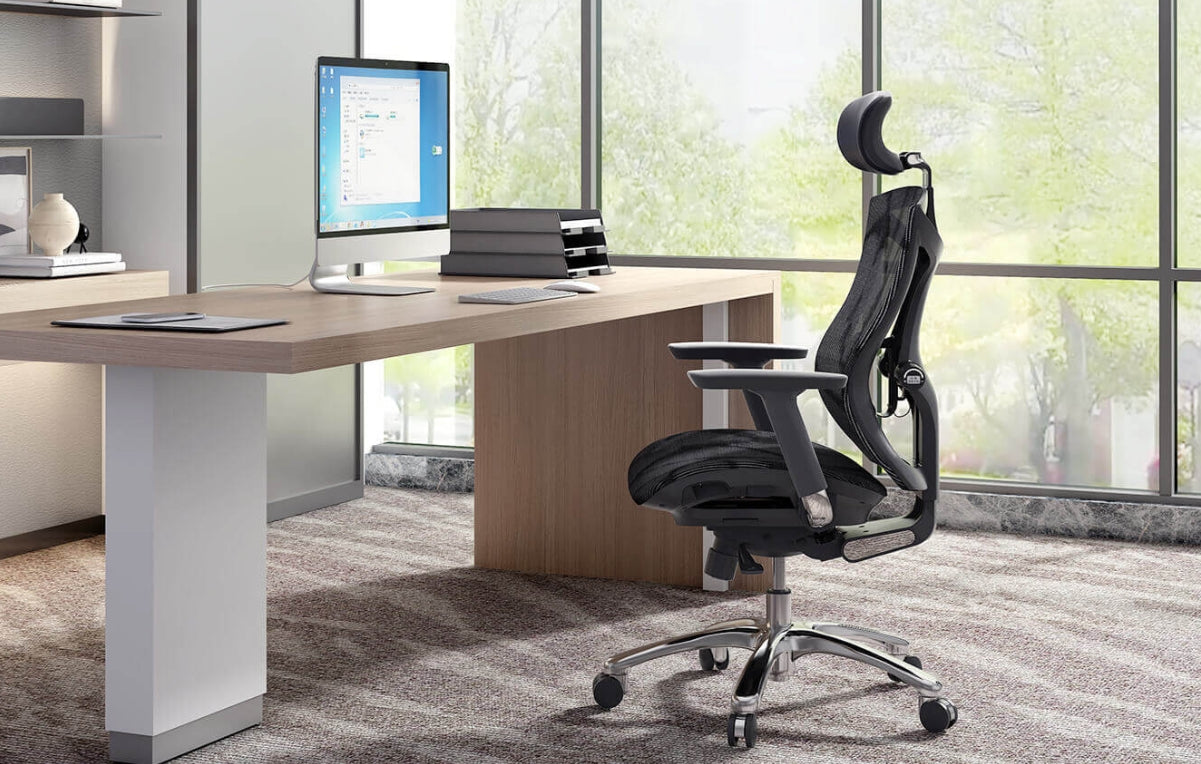Creating an ergonomic workspace is crucial for maintaining comfort and productivity, especially if you spend long hours at your desk. The heart of this setup is your ergonomic desk chair. A properly adjusted chair can prevent back pain, improve posture, and enhance overall well-being. Here’s a comprehensive guide to setting up your ergonomic desk chair for optimal comfort and support.
1. Choose the Right Chair
Before diving into adjustments, it's essential to select a chair that meets ergonomic standards. Look for these features:
- Adjustable Seat Height: Allows you to adjust the chair to your height and the height of your desk.
- Lumbar Support: Provides support to the lower back, maintaining the natural curve of the spine.
- Seat Depth Adjustment: Ensures your thighs are supported without pressure behind the knees.
- Adjustable Armrests: Allows your arms to rest comfortably without straining your shoulders.
- Swivel and Mobility: Facilitates easy movement and access to different parts of your workspace.
2. Adjust the Chair Height
Start by adjusting the chair height. Your feet should rest flat on the floor, and your knees should be at a 90-degree angle or slightly lower. To achieve this:
- Stand in front of your chair and adjust the seat height so the top of the seat is just below your kneecaps.
- Sit down and ensure your feet are flat on the floor. Use a footrest if your feet don’t reach the floor comfortably.
3. Set the Seat Depth
Seat depth is crucial for thigh support and proper blood circulation. To adjust:
- Sit back in your chair so your back is against the backrest.
- Adjust the seat depth so that there is about 2-3 inches of space between the edge of the seat and the back of your knees.
- Your thighs should be parallel to the floor, and your weight should be evenly distributed.
4. Adjust the Lumbar Support
Proper lumbar support maintains the natural curve of your spine. Here’s how to adjust it:
- Sit in your chair and position the lumbar support so it fits into the small of your back.
- Adjust the height of the lumbar support to align with your lumbar spine. It should support the natural inward curve of your lower back.
- If your chair doesn’t have built-in lumbar support, consider using an external lumbar pillow.
5. Position the Backrest
The backrest should support your entire back. To adjust:
- Sit with your back fully against the backrest.
- Adjust the angle of the backrest so that it supports your upper and lower back without pushing you forward.
- Some chairs offer a reclining feature. Set it at a slight angle (100-110 degrees) for added comfort during long sessions.
6. Adjust the Armrests
Proper armrest adjustment can reduce strain on your shoulders and neck. Here’s how:
- Adjust the height of the armrests so your elbows are at a 90-degree angle.
- Your forearms should rest comfortably on the armrests without lifting your shoulders.
- Ensure the armrests are close enough to your body to provide support without causing you to hunch or stretch.
7. Position Your Desk and Monitor
Your desk and monitor setup should complement your ergonomic chair. Here’s what to consider:
- Desk Height: Adjust your desk height so your elbows are at a 90-degree angle when typing. If your desk isn’t adjustable, adjust your chair height and use a footrest.
- Monitor Height: Your monitor should be at eye level, about 20-30 inches away from your face. The top of the screen should be at or slightly below eye level to prevent neck strain.
- Keyboard and Mouse: Place your keyboard and mouse close enough to prevent stretching. Your wrists should be straight, and your forearms parallel to the floor.
8. Take Regular Breaks
Even with the best ergonomic setup, it’s important to take breaks to move around. Prolonged sitting can lead to stiffness and decreased circulation. Consider the following:
- Stand Up and Stretch: Every 30 minutes, stand up and stretch your legs, back, and arms.
- Walk Around: Take a short walk every hour to promote blood circulation.
- Stretch Exercises: Incorporate stretching exercises into your routine to maintain flexibility and reduce muscle tension.
9. Personalize Your Setup
Your ergonomic setup should cater to your specific needs. Consider personalizing it further:
- Cushions and Supports: Use additional cushions or supports if needed for comfort.
- Desk Accessories: Organize your desk to minimize reaching and twisting. Keep frequently used items within easy reach.
- Lighting: Ensure proper lighting to reduce eye strain. Position your monitor to avoid glare.
10. Review and Adjust Regularly
Your ergonomic setup should evolve with you. Regularly review and adjust your chair and workspace to ensure continued comfort:
- Check Alignment: Periodically check your chair’s alignment and adjust as necessary.
- Listen to Your Body: Pay attention to any discomfort or strain and make adjustments promptly.
- Stay Informed: Keep up with ergonomic best practices to maintain a healthy and productive workspace.
Conclusion
An ergonomic chairs setup is vital for comfort and productivity. By carefully selecting and adjusting your chair, positioning your desk and monitor correctly, and taking regular breaks, you can create a workspace that supports your well-being. Personalizing your setup ensures it meets your specific needs, promoting a healthier and more efficient work environment. Invest time in your ergonomic setup today and reap the benefits of a more comfortable and productive tomorrow.



































